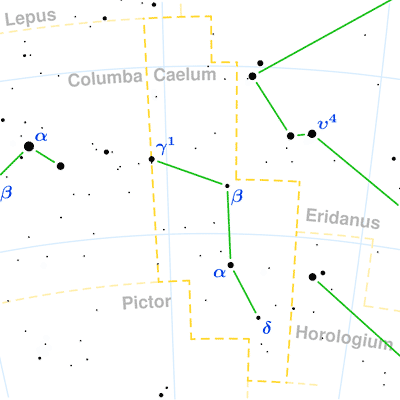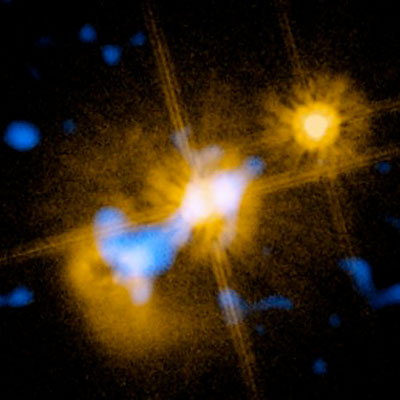Pronunciation:
(SEE-lum)Abbreviation:
CaeGenitive:
CaeliRight Ascension:
5 hoursDeclination:
-40 degreesArea in Square Degrees:
125Crosses Meridian:
9 PM, January 15Visible Between Latitudes:
40 and -90 degreesThe constellation Caelum, the sculptor’s chisel, is located in the southern hemisphere of the sky. It is visible at latitudes between 40 degrees and -90 degrees. It is a very small constellation, occupying an area of only 125 square degrees. This makes it the eighth smallest constellation in the night sky. It is bordered by Dorado and Pictor to the south, Horologium and Eridanus to the east, Lepus to the north, and Columba to the west. It is a dim constellation that can be difficult to locate in all but the darkest skies.
There are no myths associated with Caelum. It is one of the 14 southern constellations named by the French astronomer Abbé Nicolas Louis de Lacaille in the 18th century. Its name means “the chisel” in Latin. It resembles a burin, which is an engravers tool similar to a chisel. Lacaille originally named the constellation “les Burins” and depicted it as a pair of crossed burins connected by a ribbon. The name was later Latinized to Caelum Scalptorium, which means “the engraver’s chisel.” It was later shortened to Caelum by British astronomer Francis Baily at the suggestion of John Herschel.

points of interest below © Sea and Sky

© Torsten Bronger CC BY-SA 3.0
Gamma-1 Caeli
Beta Caeli
Delta Caeli
N/A
N/A
N/A
Binary Star System
Yellow-White Dwarf Star
Blue-White Subgiant Star
4.58
5.04
5.07
Caelum is an extremely dim and insignificant constellation. It contains no stars brighter than magnitude 4. The brightest star in the constellation is Alpha Caeli with a visual magnitude of only 4.46. It is a binary star system located approximately 66 light years from Earth. The second brightest star is Gamma-1 Caeli with a magnitude of 4.58. It is one of a pair of binary star systems separated by only 0.22 degrees in the sky. Its twin, Gamma-2 Caeli has a combined magnitude of only 6.34. Gamma-1 Caeli is located about 185 light years from Earth while Gamma-2 Caeli is over 334 light years away. The third brightest star in Caelum is Beta Caeli with a magnitude of only 5.04. It is a yellow-white dwarf star that lies about 90 light years from our solar system.
Caelum contains no Messier objects. Due to its small size and location away from the plane of the Milky Way, it is mostly devoid of deep-sky objects. The only notable object to be found here is HE0450-2958. It is an unusual Seyfert galaxy, also known as a quasar, with hot jets of plasma from a supermassive black hole at its center. It is extremely dim and can only be seen with the largest of telescopes.

© European Southern Observatory / CC BY 4.0



